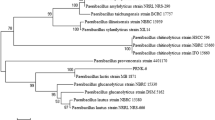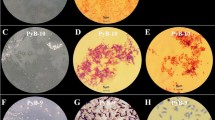Summary
Bacterial mixed cultures able to degrade the polycyclic aromatic hydrocarbons (PAH) phenanthrene, fluorene and fluoranthene, were obtained from soil using conventional enrichment techniques. From these mixed cultures three pure strains were isolated:Pseudomonas paucimobilis degrading phenanthrene;P. vesicularis degrading fluorene andAlcaligenes denitrificans degrading fluoranthene. The maximum rates of PAH degradation ranged from 1.0 mg phenanthrene/ml per day to 0.3 mg fluoranthene/ml per day at doubling times of 12 h to 35 h for growth on PAH as sole carbon source. The protein yield during PAH degradation was about 0.25 mg/mg C for all strains. Maximum PAH oxidation rates and optimum specific bacterial growth were obtained near pH 7.0 and 30°C. After growth entered the stationary phase, no dead end-products of PAH degradation could be detected in the culture fluid.
Similar content being viewed by others
References
Alexander M (1976) Introduction to soil microbiology. Wiley, New York
Atlas RM (1975) Effects of temperature and crude oil composition on petroleum biodegradation. Appl Microbiol 30:396–403
Barnsley EA (1975) The bacterial degradation of fluoranthene and benzo(a)pyrene. Can J Microbiol 21:1004–1008
Bossert ID, Bartha R (1986) Structure-biodegradability relationships of polycyclic aromatic hydrocarbons in soil. Bull Environ Contain Toxicol 37:490–495
Callahan MA, Slimak MW, Gabel NW, May IP, Fowler CF, Freed JD, Jennings P, Durfee RL, Whitmore FC, Maestri B, Mabey WR, Holt BR, Gould C (1979) Water related environmental fate of 129 priority pollutants. Vol. II. Halogenated aliphatic hydrocarbons, halogenated ethers, monocyclic aromatics, phthalate esters, polycyclic aromatic hydrocarbons, nitrosoamines and miscellaneous compounds. EPA-440/4-79-029 b, PB 80-204381
Cerniglia CE (1984) Microbial metabolism of polycyclic aromatic hydrocarbons. Adv Appl Microbiol 30:31–71
Cerniglia CE, Kelly DW, Freeman JP, Miller DW (1986) Microbial metabolism of pyrene. Chem Biol Interactions 57:203–216
Codner RC (1969) Solid and solidified growth media in microbiology. In: Norris JR, Ribons DW (eds) Methods in microbiology, vol 1. Academic Press, New York, pp 427–454
Dagley S (1986) Biochemistry of aromatic hydrocarbon degradation in Pseudomonas. In: Ornston LN, Sokatek JR (eds) The bacteria, vol 10. Academic Press, New York, pp 527–555
Gibson TD (1984) Microbial degradation of organic compounds. Dekker, New York
Hambrick GA, DeLaune RD, Patrick WH (1980) Effect of estuarine sediment pH and oxidation-reduction potential on microbial hydrocarbon degradation. Appl Environ Microbiol 40:365–369
Hammel KE, Kalyanaraman B, Kentkirk T (1986) Oxidation of PAH and dibenzo(p)dioxins by Phanerochaetechrysosporium ligninase. J Biol Chem 261:16948–16952
Heitkamp MA, Cerniglia CE (1987) Effect of chemical structure and exposure on the microbial degradation of polycyclic aromatic hydrocarbons in freshwater and estuarine ecosystems. Environ Toxicol Chem 6:535–546
Kämpfer P, Dott W (1988) Systematisierung der mikrobiologischen Untersuchungen von Boden und Wasser. In: Thome'-Kozmiensky KJ (ed) Altlasten 2. EF, Berlin, pp 649–674
Kingsbury GC, Sims RC, White JB (1979) Multimedia goals for environmental assessment. EPA-600/7-79-176b, PB 81-166548
Krieg NR, Holt JG (1984) Bergey's manual of systematic bacteriology, vol 1. Williams and Wilkins, Baltimore
Lowry OH, Rosebrough NJ, Farr AL, Randall RJ (1951) Protein measurement with the Folin phenol reagent. J Biol Chem 193:265–275
Mortelmans K, Wawarth S, Lawlor T, Speck W, Tainer B, Zeiger E (1986)Salmonella mutagenicity tests. II. Results from the testing of 270 chemicals. Environ Mutagen 8:1119
Neff JM (1979) Polycyclic aromatic hydrocarbons in the aquatic environment. Applied Science Publishers, London
Pahlmann R, Pelkonen O (1987) Mutagenicity studies of different polycyclic aromatic hydrocarbons: the significance of enzymatic factors and molecular structures. Carcinogenesis 8:773–778
Pfennig N, Lippert KD (1966) Über das Vitamin-B-12-Bedürfnis phototropher Schwefelbakterien. Arch Microbiol 55:245–256
Sims RC, Overcash MR (1983) Fate of polynuclear aromatic compounds (PNA's) in soil-plant systems. Residue Rev 88:1–68
Strandberg GW, Abraham TJ, Frazier GC (1986) Phenanthrene degradation byBeijerinckia sp. B8/36. Biotechnol Bioeng 28:142–145
Ward DM, Brock TD (1976) Environmental factors influencing the rate of hydrocarbon oxidation in temperature lakes. Appl Environ Microbiol 31:764–772
White KL (1986) An overview of immunotoxicology and carcinogenic polycyclic aromatic hydrocarbons. Environ Carcinogen Rev C4:163–202
Williams PA (1978) Microbial genetics relating to hydrocarbon degradation. In: Watkinson RJ (ed) Development in biodegradation of hydrocarbons. Applied Science Publishers, London, pp 135–164
Wodzinski RS, Bertolini D (1972) Physical state in which naphthalene and bibenzyl are utilized by bacteria. Appl Microbiol 23:1077–1084
Wodzinski RS, Coyle JE (1974) Physical state of phenanthrene for utilization by bacteria. Appl Microbiol 27:1081–1084
ZoBell CE (1973) Microbial degradation of oil: present status, problems and perspectives. In: Ahearn DG, Meyers SP (eds) The microbial degradation of oil pollutants. Public. no LSU-5G-73-O1, Center for Wetland Resources, Lousiana State University, Baton Rouge, La, pp 3–16
Author information
Authors and Affiliations
Rights and permissions
About this article
Cite this article
Weissenfels, W.D., Beyer, M. & Klein, J. Degradation of phenanthrene, fluorene and fluoranthene by pure bacterial cultures. Appl Microbiol Biotechnol 32, 479–484 (1990). https://doi.org/10.1007/BF00903787
Received:
Accepted:
Issue Date:
DOI: https://doi.org/10.1007/BF00903787




